Emergency Response Plan for Ebola Outbreak and Community Engagement
VerifiedAdded on 2022/09/16
|10
|2424
|15
Report
AI Summary
This report presents an emergency response plan designed to address a hypothetical Ebola virus outbreak, emphasizing community engagement and mobilization as crucial components of an effective strategy. The plan meticulously outlines a step-by-step approach that ensures active community involvement alongside authorities and health agencies, covering engagement, consultation, participation, organization, action, and empowerment stages. The report discusses the importance of both top-down and bottom-up approaches in emergency preparedness, highlighting their respective advantages and disadvantages in the context of public health emergencies. It also analyzes the practical application of knowledge, skills, and attitudes (KSAs) for public health workers, emphasizing the significance of infection control mechanisms, resource allocation, and the establishment of clear communication channels. The author emphasizes the need for early risk identification, team building, information accessibility, and regular plan testing to mitigate the virus's spread, with references to relevant literature and models. The plan also considers the importance of the role of the local communities and the healthcare authorities to fight the disease. The report concludes by underscoring the need for proactive measures and the use of emergency response plans for other communicable diseases.
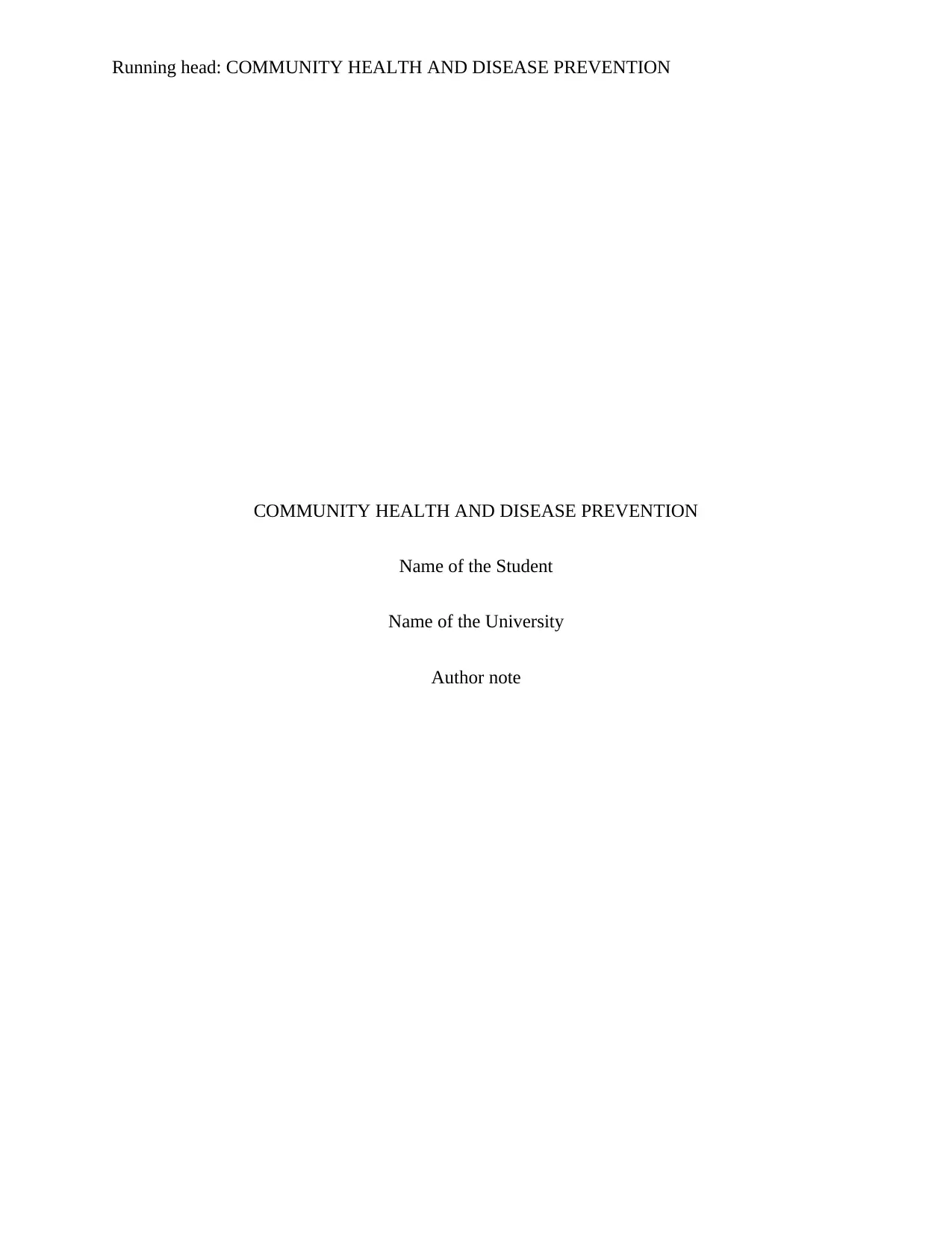
Running head: COMMUNITY HEALTH AND DISEASE PREVENTION
COMMUNITY HEALTH AND DISEASE PREVENTION
Name of the Student
Name of the University
Author note
COMMUNITY HEALTH AND DISEASE PREVENTION
Name of the Student
Name of the University
Author note
Paraphrase This Document
Need a fresh take? Get an instant paraphrase of this document with our AI Paraphraser
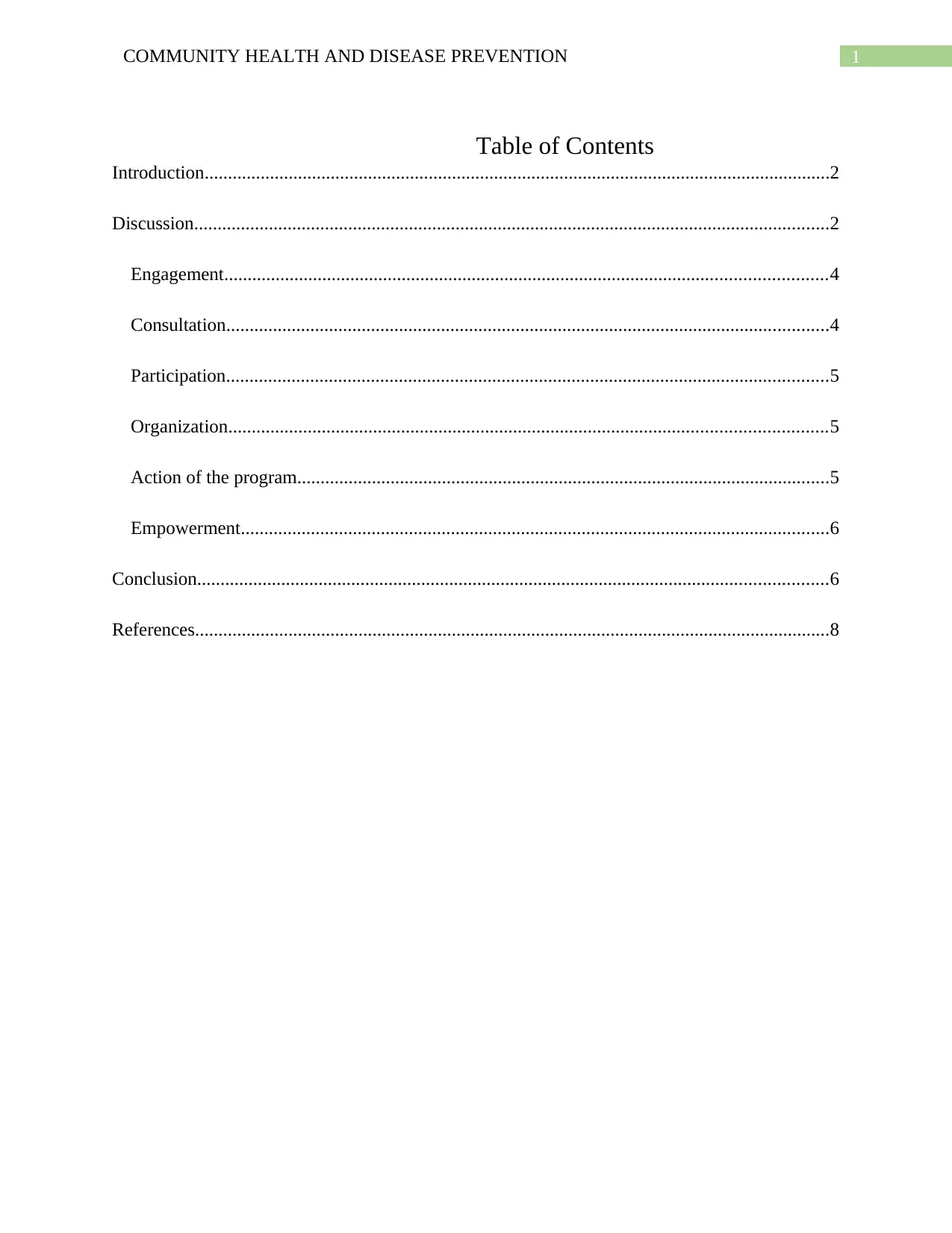
1COMMUNITY HEALTH AND DISEASE PREVENTION
Table of Contents
Introduction......................................................................................................................................2
Discussion........................................................................................................................................2
Engagement.................................................................................................................................4
Consultation.................................................................................................................................4
Participation.................................................................................................................................5
Organization................................................................................................................................5
Action of the program..................................................................................................................5
Empowerment..............................................................................................................................6
Conclusion.......................................................................................................................................6
References........................................................................................................................................8
Table of Contents
Introduction......................................................................................................................................2
Discussion........................................................................................................................................2
Engagement.................................................................................................................................4
Consultation.................................................................................................................................4
Participation.................................................................................................................................5
Organization................................................................................................................................5
Action of the program..................................................................................................................5
Empowerment..............................................................................................................................6
Conclusion.......................................................................................................................................6
References........................................................................................................................................8
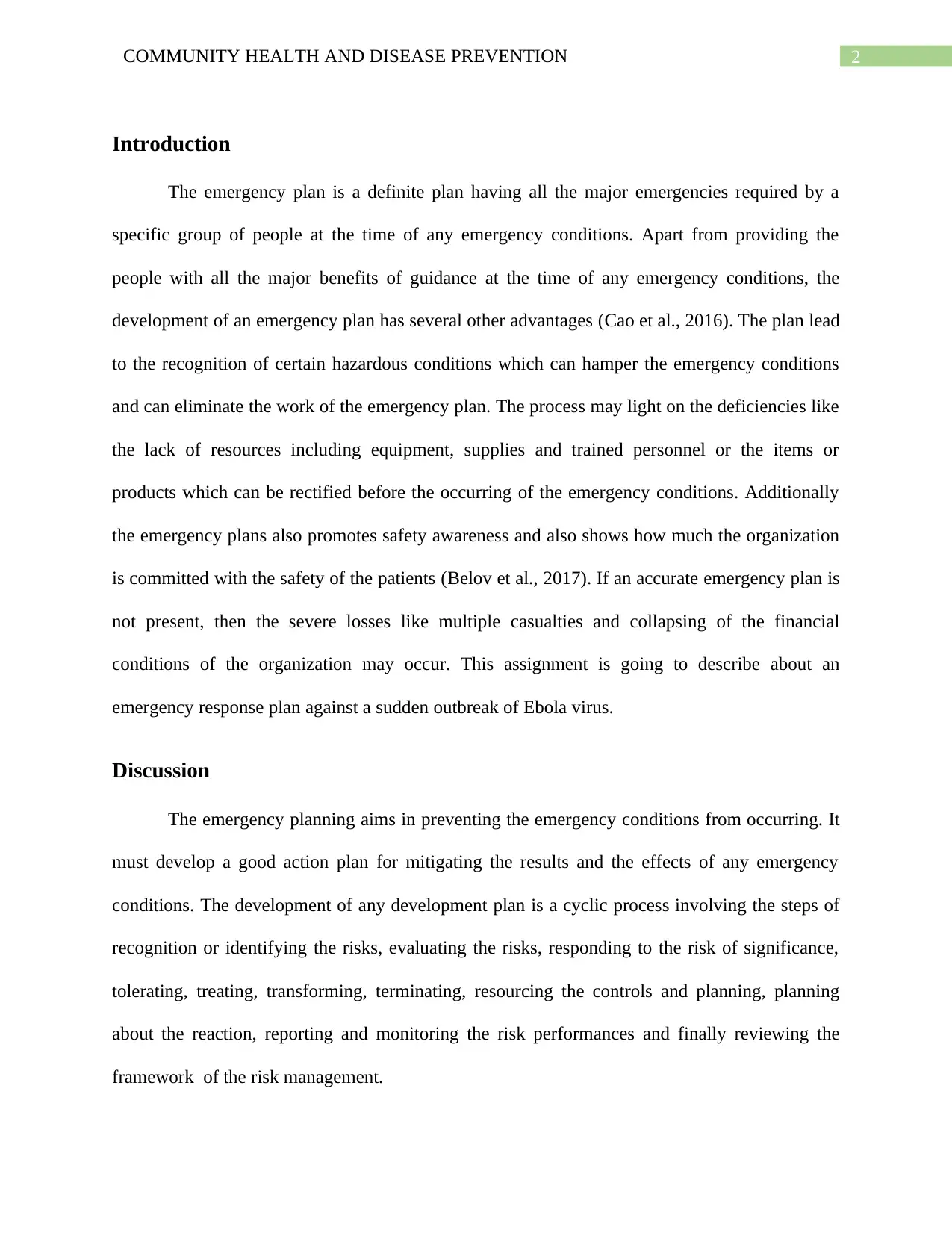
2COMMUNITY HEALTH AND DISEASE PREVENTION
Introduction
The emergency plan is a definite plan having all the major emergencies required by a
specific group of people at the time of any emergency conditions. Apart from providing the
people with all the major benefits of guidance at the time of any emergency conditions, the
development of an emergency plan has several other advantages (Cao et al., 2016). The plan lead
to the recognition of certain hazardous conditions which can hamper the emergency conditions
and can eliminate the work of the emergency plan. The process may light on the deficiencies like
the lack of resources including equipment, supplies and trained personnel or the items or
products which can be rectified before the occurring of the emergency conditions. Additionally
the emergency plans also promotes safety awareness and also shows how much the organization
is committed with the safety of the patients (Belov et al., 2017). If an accurate emergency plan is
not present, then the severe losses like multiple casualties and collapsing of the financial
conditions of the organization may occur. This assignment is going to describe about an
emergency response plan against a sudden outbreak of Ebola virus.
Discussion
The emergency planning aims in preventing the emergency conditions from occurring. It
must develop a good action plan for mitigating the results and the effects of any emergency
conditions. The development of any development plan is a cyclic process involving the steps of
recognition or identifying the risks, evaluating the risks, responding to the risk of significance,
tolerating, treating, transforming, terminating, resourcing the controls and planning, planning
about the reaction, reporting and monitoring the risk performances and finally reviewing the
framework of the risk management.
Introduction
The emergency plan is a definite plan having all the major emergencies required by a
specific group of people at the time of any emergency conditions. Apart from providing the
people with all the major benefits of guidance at the time of any emergency conditions, the
development of an emergency plan has several other advantages (Cao et al., 2016). The plan lead
to the recognition of certain hazardous conditions which can hamper the emergency conditions
and can eliminate the work of the emergency plan. The process may light on the deficiencies like
the lack of resources including equipment, supplies and trained personnel or the items or
products which can be rectified before the occurring of the emergency conditions. Additionally
the emergency plans also promotes safety awareness and also shows how much the organization
is committed with the safety of the patients (Belov et al., 2017). If an accurate emergency plan is
not present, then the severe losses like multiple casualties and collapsing of the financial
conditions of the organization may occur. This assignment is going to describe about an
emergency response plan against a sudden outbreak of Ebola virus.
Discussion
The emergency planning aims in preventing the emergency conditions from occurring. It
must develop a good action plan for mitigating the results and the effects of any emergency
conditions. The development of any development plan is a cyclic process involving the steps of
recognition or identifying the risks, evaluating the risks, responding to the risk of significance,
tolerating, treating, transforming, terminating, resourcing the controls and planning, planning
about the reaction, reporting and monitoring the risk performances and finally reviewing the
framework of the risk management.
⊘ This is a preview!⊘
Do you want full access?
Subscribe today to unlock all pages.

Trusted by 1+ million students worldwide
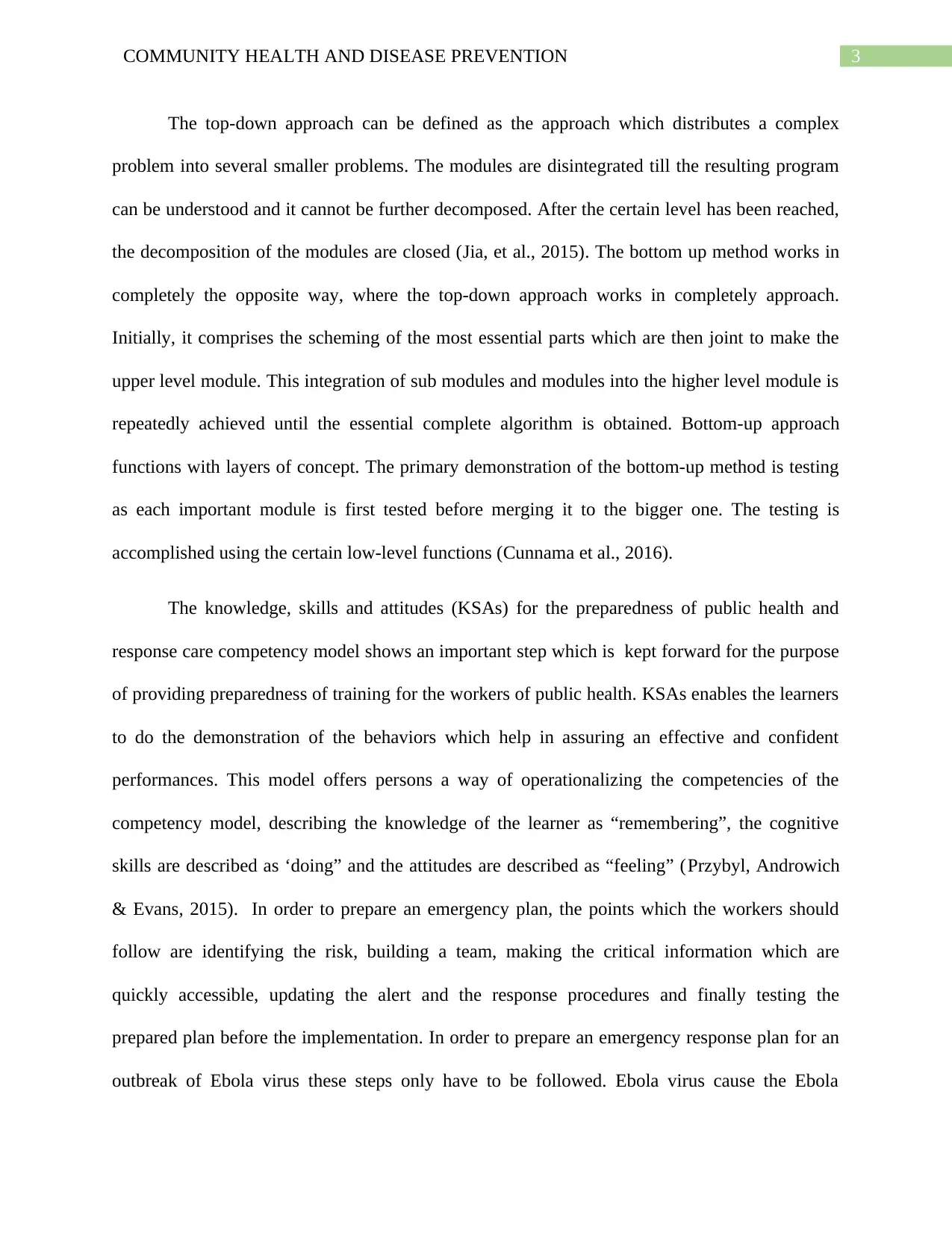
3COMMUNITY HEALTH AND DISEASE PREVENTION
The top-down approach can be defined as the approach which distributes a complex
problem into several smaller problems. The modules are disintegrated till the resulting program
can be understood and it cannot be further decomposed. After the certain level has been reached,
the decomposition of the modules are closed (Jia, et al., 2015). The bottom up method works in
completely the opposite way, where the top-down approach works in completely approach.
Initially, it comprises the scheming of the most essential parts which are then joint to make the
upper level module. This integration of sub modules and modules into the higher level module is
repeatedly achieved until the essential complete algorithm is obtained. Bottom-up approach
functions with layers of concept. The primary demonstration of the bottom-up method is testing
as each important module is first tested before merging it to the bigger one. The testing is
accomplished using the certain low-level functions (Cunnama et al., 2016).
The knowledge, skills and attitudes (KSAs) for the preparedness of public health and
response care competency model shows an important step which is kept forward for the purpose
of providing preparedness of training for the workers of public health. KSAs enables the learners
to do the demonstration of the behaviors which help in assuring an effective and confident
performances. This model offers persons a way of operationalizing the competencies of the
competency model, describing the knowledge of the learner as “remembering”, the cognitive
skills are described as ‘doing” and the attitudes are described as “feeling” (Przybyl, Androwich
& Evans, 2015). In order to prepare an emergency plan, the points which the workers should
follow are identifying the risk, building a team, making the critical information which are
quickly accessible, updating the alert and the response procedures and finally testing the
prepared plan before the implementation. In order to prepare an emergency response plan for an
outbreak of Ebola virus these steps only have to be followed. Ebola virus cause the Ebola
The top-down approach can be defined as the approach which distributes a complex
problem into several smaller problems. The modules are disintegrated till the resulting program
can be understood and it cannot be further decomposed. After the certain level has been reached,
the decomposition of the modules are closed (Jia, et al., 2015). The bottom up method works in
completely the opposite way, where the top-down approach works in completely approach.
Initially, it comprises the scheming of the most essential parts which are then joint to make the
upper level module. This integration of sub modules and modules into the higher level module is
repeatedly achieved until the essential complete algorithm is obtained. Bottom-up approach
functions with layers of concept. The primary demonstration of the bottom-up method is testing
as each important module is first tested before merging it to the bigger one. The testing is
accomplished using the certain low-level functions (Cunnama et al., 2016).
The knowledge, skills and attitudes (KSAs) for the preparedness of public health and
response care competency model shows an important step which is kept forward for the purpose
of providing preparedness of training for the workers of public health. KSAs enables the learners
to do the demonstration of the behaviors which help in assuring an effective and confident
performances. This model offers persons a way of operationalizing the competencies of the
competency model, describing the knowledge of the learner as “remembering”, the cognitive
skills are described as ‘doing” and the attitudes are described as “feeling” (Przybyl, Androwich
& Evans, 2015). In order to prepare an emergency plan, the points which the workers should
follow are identifying the risk, building a team, making the critical information which are
quickly accessible, updating the alert and the response procedures and finally testing the
prepared plan before the implementation. In order to prepare an emergency response plan for an
outbreak of Ebola virus these steps only have to be followed. Ebola virus cause the Ebola
Paraphrase This Document
Need a fresh take? Get an instant paraphrase of this document with our AI Paraphraser
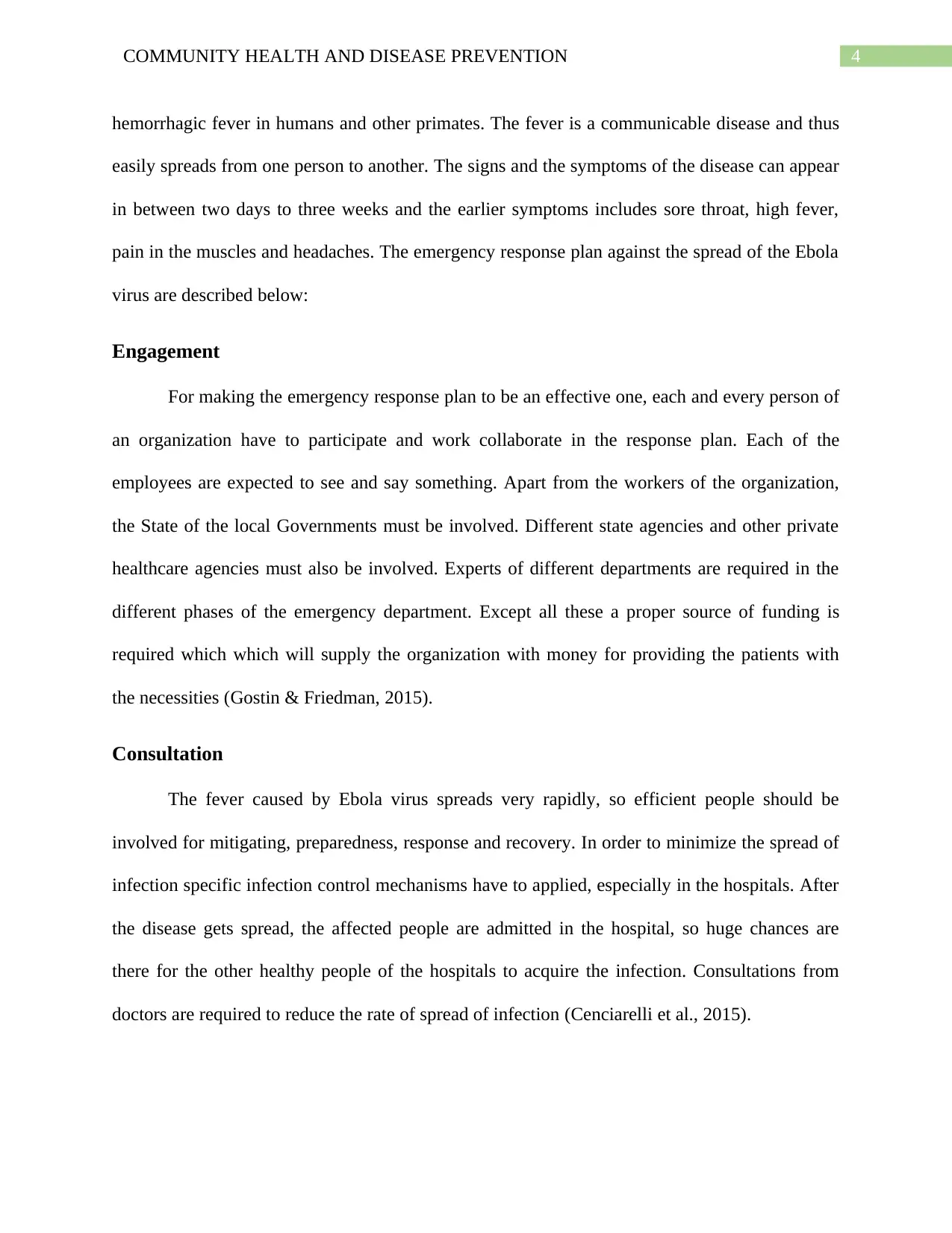
4COMMUNITY HEALTH AND DISEASE PREVENTION
hemorrhagic fever in humans and other primates. The fever is a communicable disease and thus
easily spreads from one person to another. The signs and the symptoms of the disease can appear
in between two days to three weeks and the earlier symptoms includes sore throat, high fever,
pain in the muscles and headaches. The emergency response plan against the spread of the Ebola
virus are described below:
Engagement
For making the emergency response plan to be an effective one, each and every person of
an organization have to participate and work collaborate in the response plan. Each of the
employees are expected to see and say something. Apart from the workers of the organization,
the State of the local Governments must be involved. Different state agencies and other private
healthcare agencies must also be involved. Experts of different departments are required in the
different phases of the emergency department. Except all these a proper source of funding is
required which which will supply the organization with money for providing the patients with
the necessities (Gostin & Friedman, 2015).
Consultation
The fever caused by Ebola virus spreads very rapidly, so efficient people should be
involved for mitigating, preparedness, response and recovery. In order to minimize the spread of
infection specific infection control mechanisms have to applied, especially in the hospitals. After
the disease gets spread, the affected people are admitted in the hospital, so huge chances are
there for the other healthy people of the hospitals to acquire the infection. Consultations from
doctors are required to reduce the rate of spread of infection (Cenciarelli et al., 2015).
hemorrhagic fever in humans and other primates. The fever is a communicable disease and thus
easily spreads from one person to another. The signs and the symptoms of the disease can appear
in between two days to three weeks and the earlier symptoms includes sore throat, high fever,
pain in the muscles and headaches. The emergency response plan against the spread of the Ebola
virus are described below:
Engagement
For making the emergency response plan to be an effective one, each and every person of
an organization have to participate and work collaborate in the response plan. Each of the
employees are expected to see and say something. Apart from the workers of the organization,
the State of the local Governments must be involved. Different state agencies and other private
healthcare agencies must also be involved. Experts of different departments are required in the
different phases of the emergency department. Except all these a proper source of funding is
required which which will supply the organization with money for providing the patients with
the necessities (Gostin & Friedman, 2015).
Consultation
The fever caused by Ebola virus spreads very rapidly, so efficient people should be
involved for mitigating, preparedness, response and recovery. In order to minimize the spread of
infection specific infection control mechanisms have to applied, especially in the hospitals. After
the disease gets spread, the affected people are admitted in the hospital, so huge chances are
there for the other healthy people of the hospitals to acquire the infection. Consultations from
doctors are required to reduce the rate of spread of infection (Cenciarelli et al., 2015).
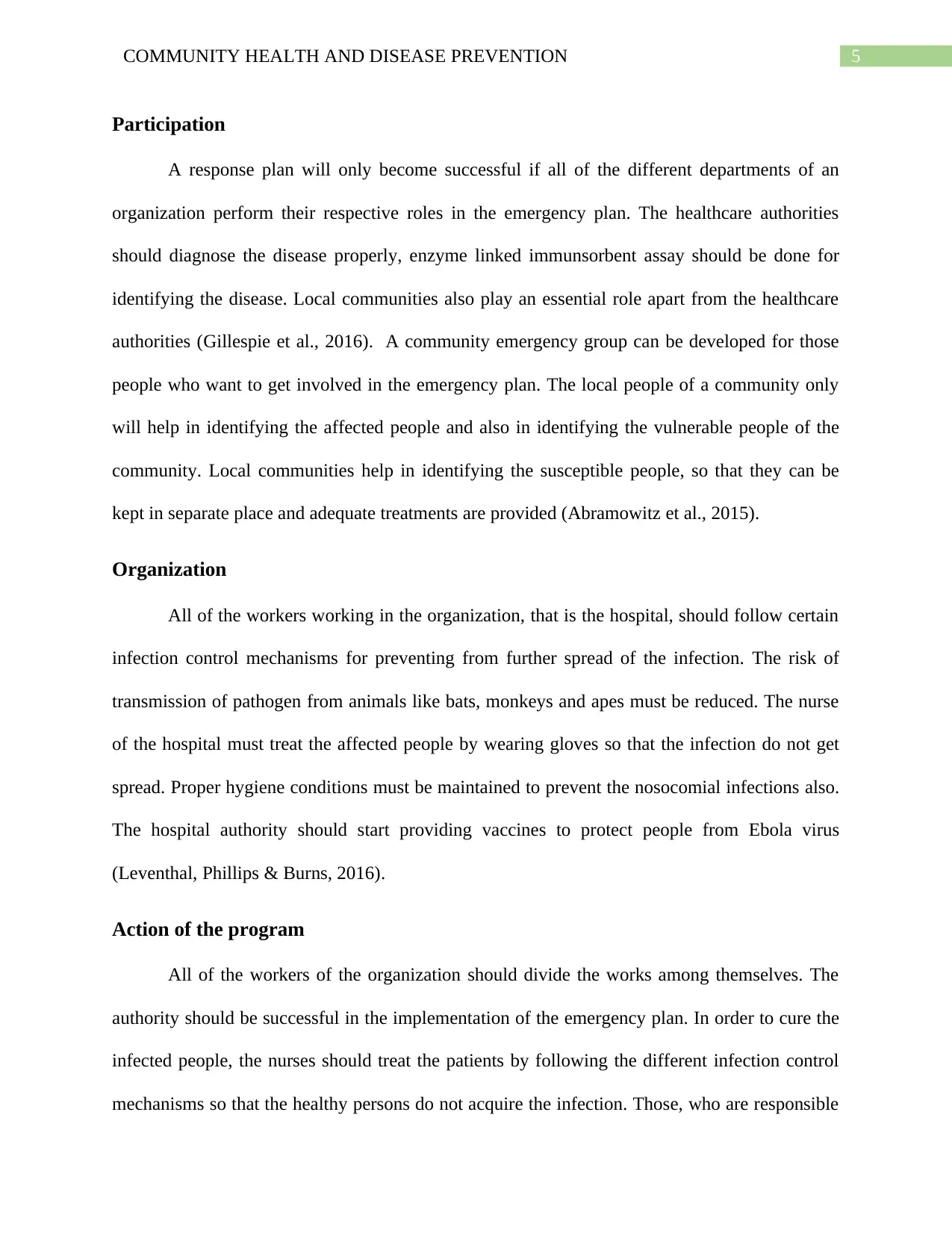
5COMMUNITY HEALTH AND DISEASE PREVENTION
Participation
A response plan will only become successful if all of the different departments of an
organization perform their respective roles in the emergency plan. The healthcare authorities
should diagnose the disease properly, enzyme linked immunsorbent assay should be done for
identifying the disease. Local communities also play an essential role apart from the healthcare
authorities (Gillespie et al., 2016). A community emergency group can be developed for those
people who want to get involved in the emergency plan. The local people of a community only
will help in identifying the affected people and also in identifying the vulnerable people of the
community. Local communities help in identifying the susceptible people, so that they can be
kept in separate place and adequate treatments are provided (Abramowitz et al., 2015).
Organization
All of the workers working in the organization, that is the hospital, should follow certain
infection control mechanisms for preventing from further spread of the infection. The risk of
transmission of pathogen from animals like bats, monkeys and apes must be reduced. The nurse
of the hospital must treat the affected people by wearing gloves so that the infection do not get
spread. Proper hygiene conditions must be maintained to prevent the nosocomial infections also.
The hospital authority should start providing vaccines to protect people from Ebola virus
(Leventhal, Phillips & Burns, 2016).
Action of the program
All of the workers of the organization should divide the works among themselves. The
authority should be successful in the implementation of the emergency plan. In order to cure the
infected people, the nurses should treat the patients by following the different infection control
mechanisms so that the healthy persons do not acquire the infection. Those, who are responsible
Participation
A response plan will only become successful if all of the different departments of an
organization perform their respective roles in the emergency plan. The healthcare authorities
should diagnose the disease properly, enzyme linked immunsorbent assay should be done for
identifying the disease. Local communities also play an essential role apart from the healthcare
authorities (Gillespie et al., 2016). A community emergency group can be developed for those
people who want to get involved in the emergency plan. The local people of a community only
will help in identifying the affected people and also in identifying the vulnerable people of the
community. Local communities help in identifying the susceptible people, so that they can be
kept in separate place and adequate treatments are provided (Abramowitz et al., 2015).
Organization
All of the workers working in the organization, that is the hospital, should follow certain
infection control mechanisms for preventing from further spread of the infection. The risk of
transmission of pathogen from animals like bats, monkeys and apes must be reduced. The nurse
of the hospital must treat the affected people by wearing gloves so that the infection do not get
spread. Proper hygiene conditions must be maintained to prevent the nosocomial infections also.
The hospital authority should start providing vaccines to protect people from Ebola virus
(Leventhal, Phillips & Burns, 2016).
Action of the program
All of the workers of the organization should divide the works among themselves. The
authority should be successful in the implementation of the emergency plan. In order to cure the
infected people, the nurses should treat the patients by following the different infection control
mechanisms so that the healthy persons do not acquire the infection. Those, who are responsible
⊘ This is a preview!⊘
Do you want full access?
Subscribe today to unlock all pages.

Trusted by 1+ million students worldwide
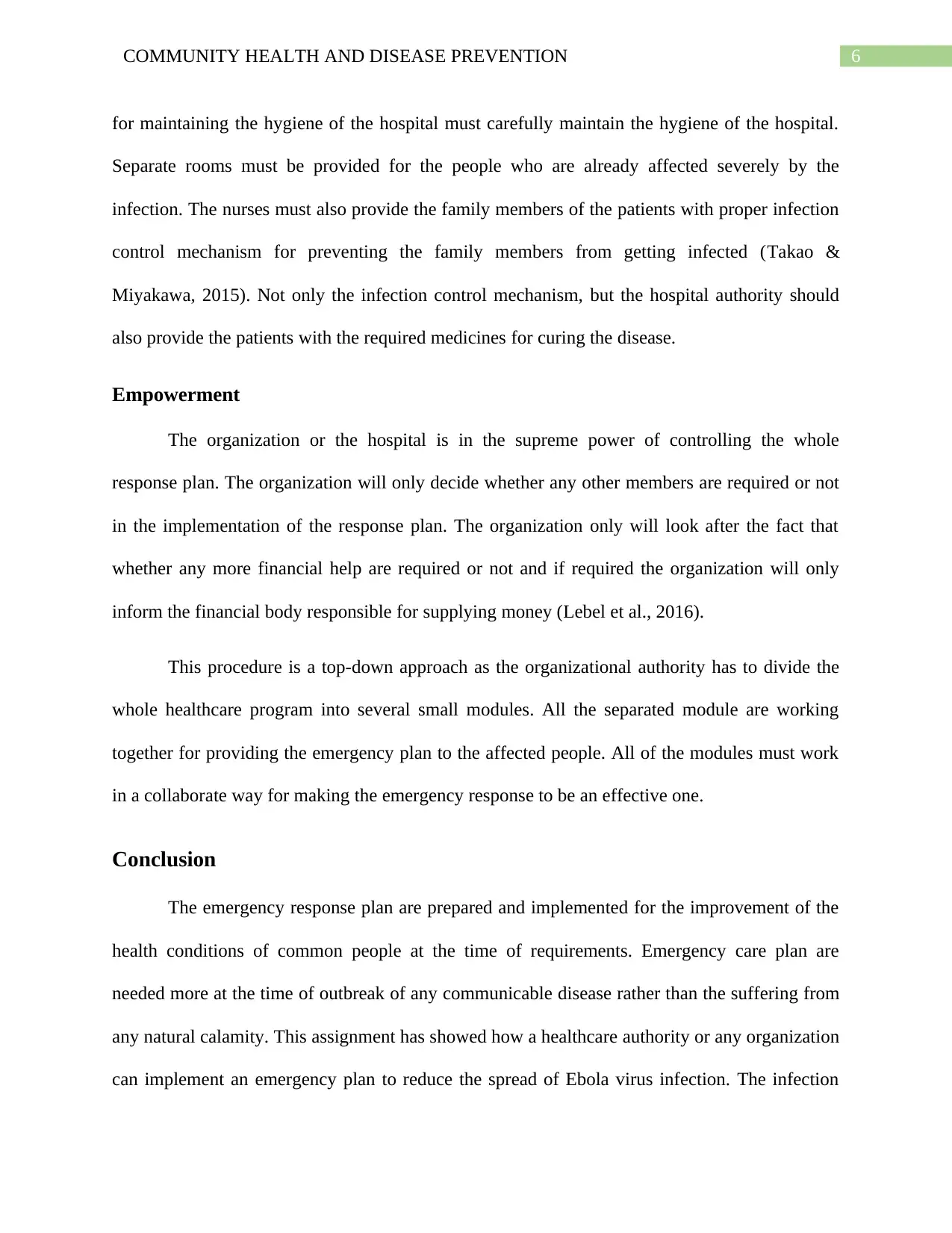
6COMMUNITY HEALTH AND DISEASE PREVENTION
for maintaining the hygiene of the hospital must carefully maintain the hygiene of the hospital.
Separate rooms must be provided for the people who are already affected severely by the
infection. The nurses must also provide the family members of the patients with proper infection
control mechanism for preventing the family members from getting infected (Takao &
Miyakawa, 2015). Not only the infection control mechanism, but the hospital authority should
also provide the patients with the required medicines for curing the disease.
Empowerment
The organization or the hospital is in the supreme power of controlling the whole
response plan. The organization will only decide whether any other members are required or not
in the implementation of the response plan. The organization only will look after the fact that
whether any more financial help are required or not and if required the organization will only
inform the financial body responsible for supplying money (Lebel et al., 2016).
This procedure is a top-down approach as the organizational authority has to divide the
whole healthcare program into several small modules. All the separated module are working
together for providing the emergency plan to the affected people. All of the modules must work
in a collaborate way for making the emergency response to be an effective one.
Conclusion
The emergency response plan are prepared and implemented for the improvement of the
health conditions of common people at the time of requirements. Emergency care plan are
needed more at the time of outbreak of any communicable disease rather than the suffering from
any natural calamity. This assignment has showed how a healthcare authority or any organization
can implement an emergency plan to reduce the spread of Ebola virus infection. The infection
for maintaining the hygiene of the hospital must carefully maintain the hygiene of the hospital.
Separate rooms must be provided for the people who are already affected severely by the
infection. The nurses must also provide the family members of the patients with proper infection
control mechanism for preventing the family members from getting infected (Takao &
Miyakawa, 2015). Not only the infection control mechanism, but the hospital authority should
also provide the patients with the required medicines for curing the disease.
Empowerment
The organization or the hospital is in the supreme power of controlling the whole
response plan. The organization will only decide whether any other members are required or not
in the implementation of the response plan. The organization only will look after the fact that
whether any more financial help are required or not and if required the organization will only
inform the financial body responsible for supplying money (Lebel et al., 2016).
This procedure is a top-down approach as the organizational authority has to divide the
whole healthcare program into several small modules. All the separated module are working
together for providing the emergency plan to the affected people. All of the modules must work
in a collaborate way for making the emergency response to be an effective one.
Conclusion
The emergency response plan are prepared and implemented for the improvement of the
health conditions of common people at the time of requirements. Emergency care plan are
needed more at the time of outbreak of any communicable disease rather than the suffering from
any natural calamity. This assignment has showed how a healthcare authority or any organization
can implement an emergency plan to reduce the spread of Ebola virus infection. The infection
Paraphrase This Document
Need a fresh take? Get an instant paraphrase of this document with our AI Paraphraser
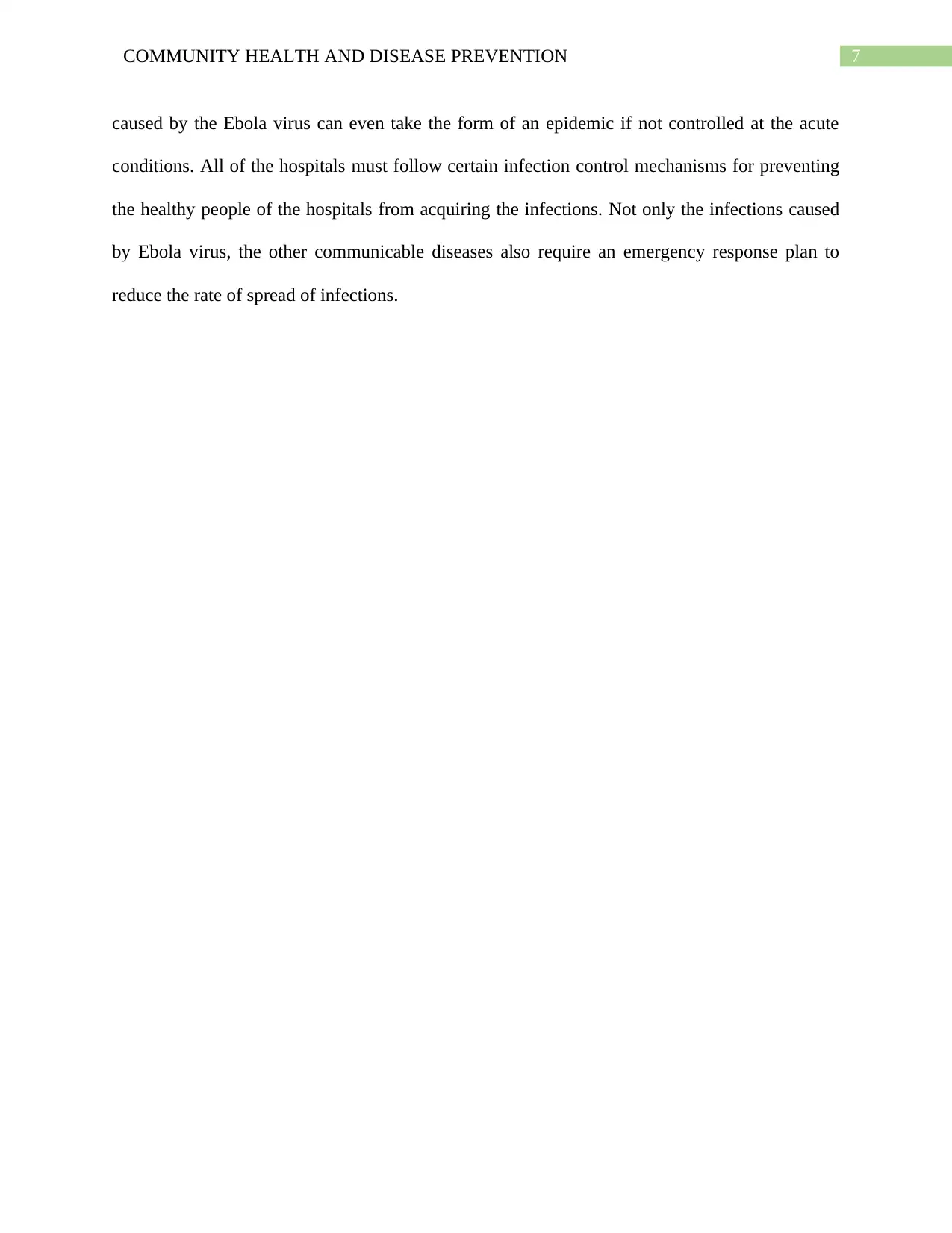
7COMMUNITY HEALTH AND DISEASE PREVENTION
caused by the Ebola virus can even take the form of an epidemic if not controlled at the acute
conditions. All of the hospitals must follow certain infection control mechanisms for preventing
the healthy people of the hospitals from acquiring the infections. Not only the infections caused
by Ebola virus, the other communicable diseases also require an emergency response plan to
reduce the rate of spread of infections.
caused by the Ebola virus can even take the form of an epidemic if not controlled at the acute
conditions. All of the hospitals must follow certain infection control mechanisms for preventing
the healthy people of the hospitals from acquiring the infections. Not only the infections caused
by Ebola virus, the other communicable diseases also require an emergency response plan to
reduce the rate of spread of infections.
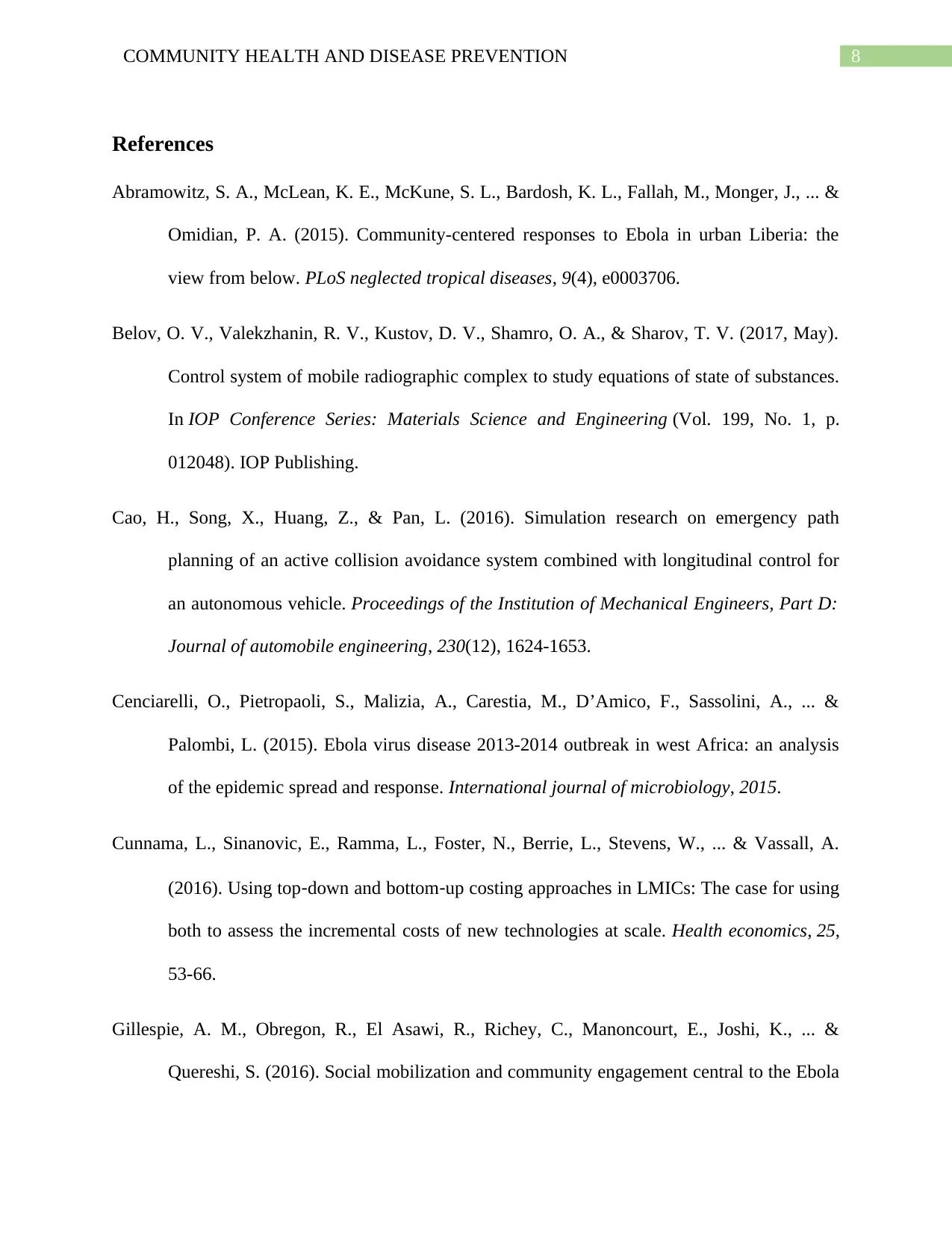
8COMMUNITY HEALTH AND DISEASE PREVENTION
References
Abramowitz, S. A., McLean, K. E., McKune, S. L., Bardosh, K. L., Fallah, M., Monger, J., ... &
Omidian, P. A. (2015). Community-centered responses to Ebola in urban Liberia: the
view from below. PLoS neglected tropical diseases, 9(4), e0003706.
Belov, O. V., Valekzhanin, R. V., Kustov, D. V., Shamro, O. A., & Sharov, T. V. (2017, May).
Control system of mobile radiographic complex to study equations of state of substances.
In IOP Conference Series: Materials Science and Engineering (Vol. 199, No. 1, p.
012048). IOP Publishing.
Cao, H., Song, X., Huang, Z., & Pan, L. (2016). Simulation research on emergency path
planning of an active collision avoidance system combined with longitudinal control for
an autonomous vehicle. Proceedings of the Institution of Mechanical Engineers, Part D:
Journal of automobile engineering, 230(12), 1624-1653.
Cenciarelli, O., Pietropaoli, S., Malizia, A., Carestia, M., D’Amico, F., Sassolini, A., ... &
Palombi, L. (2015). Ebola virus disease 2013-2014 outbreak in west Africa: an analysis
of the epidemic spread and response. International journal of microbiology, 2015.
Cunnama, L., Sinanovic, E., Ramma, L., Foster, N., Berrie, L., Stevens, W., ... & Vassall, A.
(2016). Using top‐down and bottom‐up costing approaches in LMICs: The case for using
both to assess the incremental costs of new technologies at scale. Health economics, 25,
53-66.
Gillespie, A. M., Obregon, R., El Asawi, R., Richey, C., Manoncourt, E., Joshi, K., ... &
Quereshi, S. (2016). Social mobilization and community engagement central to the Ebola
References
Abramowitz, S. A., McLean, K. E., McKune, S. L., Bardosh, K. L., Fallah, M., Monger, J., ... &
Omidian, P. A. (2015). Community-centered responses to Ebola in urban Liberia: the
view from below. PLoS neglected tropical diseases, 9(4), e0003706.
Belov, O. V., Valekzhanin, R. V., Kustov, D. V., Shamro, O. A., & Sharov, T. V. (2017, May).
Control system of mobile radiographic complex to study equations of state of substances.
In IOP Conference Series: Materials Science and Engineering (Vol. 199, No. 1, p.
012048). IOP Publishing.
Cao, H., Song, X., Huang, Z., & Pan, L. (2016). Simulation research on emergency path
planning of an active collision avoidance system combined with longitudinal control for
an autonomous vehicle. Proceedings of the Institution of Mechanical Engineers, Part D:
Journal of automobile engineering, 230(12), 1624-1653.
Cenciarelli, O., Pietropaoli, S., Malizia, A., Carestia, M., D’Amico, F., Sassolini, A., ... &
Palombi, L. (2015). Ebola virus disease 2013-2014 outbreak in west Africa: an analysis
of the epidemic spread and response. International journal of microbiology, 2015.
Cunnama, L., Sinanovic, E., Ramma, L., Foster, N., Berrie, L., Stevens, W., ... & Vassall, A.
(2016). Using top‐down and bottom‐up costing approaches in LMICs: The case for using
both to assess the incremental costs of new technologies at scale. Health economics, 25,
53-66.
Gillespie, A. M., Obregon, R., El Asawi, R., Richey, C., Manoncourt, E., Joshi, K., ... &
Quereshi, S. (2016). Social mobilization and community engagement central to the Ebola
⊘ This is a preview!⊘
Do you want full access?
Subscribe today to unlock all pages.

Trusted by 1+ million students worldwide
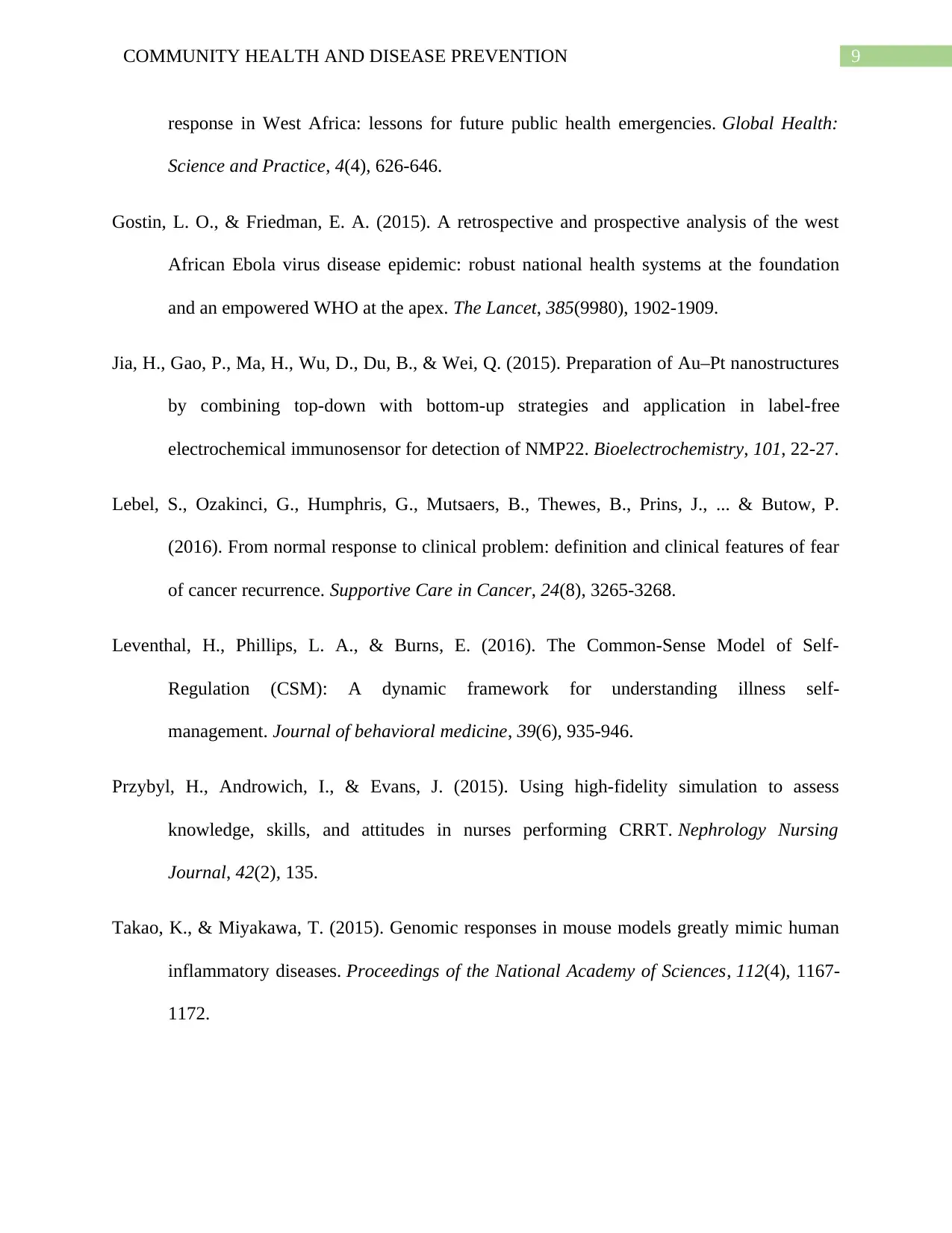
9COMMUNITY HEALTH AND DISEASE PREVENTION
response in West Africa: lessons for future public health emergencies. Global Health:
Science and Practice, 4(4), 626-646.
Gostin, L. O., & Friedman, E. A. (2015). A retrospective and prospective analysis of the west
African Ebola virus disease epidemic: robust national health systems at the foundation
and an empowered WHO at the apex. The Lancet, 385(9980), 1902-1909.
Jia, H., Gao, P., Ma, H., Wu, D., Du, B., & Wei, Q. (2015). Preparation of Au–Pt nanostructures
by combining top-down with bottom-up strategies and application in label-free
electrochemical immunosensor for detection of NMP22. Bioelectrochemistry, 101, 22-27.
Lebel, S., Ozakinci, G., Humphris, G., Mutsaers, B., Thewes, B., Prins, J., ... & Butow, P.
(2016). From normal response to clinical problem: definition and clinical features of fear
of cancer recurrence. Supportive Care in Cancer, 24(8), 3265-3268.
Leventhal, H., Phillips, L. A., & Burns, E. (2016). The Common-Sense Model of Self-
Regulation (CSM): A dynamic framework for understanding illness self-
management. Journal of behavioral medicine, 39(6), 935-946.
Przybyl, H., Androwich, I., & Evans, J. (2015). Using high-fidelity simulation to assess
knowledge, skills, and attitudes in nurses performing CRRT. Nephrology Nursing
Journal, 42(2), 135.
Takao, K., & Miyakawa, T. (2015). Genomic responses in mouse models greatly mimic human
inflammatory diseases. Proceedings of the National Academy of Sciences, 112(4), 1167-
1172.
response in West Africa: lessons for future public health emergencies. Global Health:
Science and Practice, 4(4), 626-646.
Gostin, L. O., & Friedman, E. A. (2015). A retrospective and prospective analysis of the west
African Ebola virus disease epidemic: robust national health systems at the foundation
and an empowered WHO at the apex. The Lancet, 385(9980), 1902-1909.
Jia, H., Gao, P., Ma, H., Wu, D., Du, B., & Wei, Q. (2015). Preparation of Au–Pt nanostructures
by combining top-down with bottom-up strategies and application in label-free
electrochemical immunosensor for detection of NMP22. Bioelectrochemistry, 101, 22-27.
Lebel, S., Ozakinci, G., Humphris, G., Mutsaers, B., Thewes, B., Prins, J., ... & Butow, P.
(2016). From normal response to clinical problem: definition and clinical features of fear
of cancer recurrence. Supportive Care in Cancer, 24(8), 3265-3268.
Leventhal, H., Phillips, L. A., & Burns, E. (2016). The Common-Sense Model of Self-
Regulation (CSM): A dynamic framework for understanding illness self-
management. Journal of behavioral medicine, 39(6), 935-946.
Przybyl, H., Androwich, I., & Evans, J. (2015). Using high-fidelity simulation to assess
knowledge, skills, and attitudes in nurses performing CRRT. Nephrology Nursing
Journal, 42(2), 135.
Takao, K., & Miyakawa, T. (2015). Genomic responses in mouse models greatly mimic human
inflammatory diseases. Proceedings of the National Academy of Sciences, 112(4), 1167-
1172.
1 out of 10
Related Documents
Your All-in-One AI-Powered Toolkit for Academic Success.
+13062052269
info@desklib.com
Available 24*7 on WhatsApp / Email
![[object Object]](/_next/static/media/star-bottom.7253800d.svg)
Unlock your academic potential
Copyright © 2020–2025 A2Z Services. All Rights Reserved. Developed and managed by ZUCOL.





